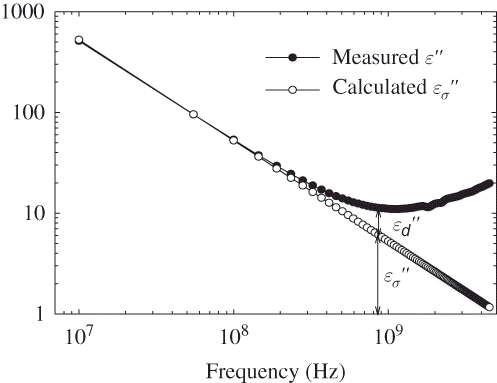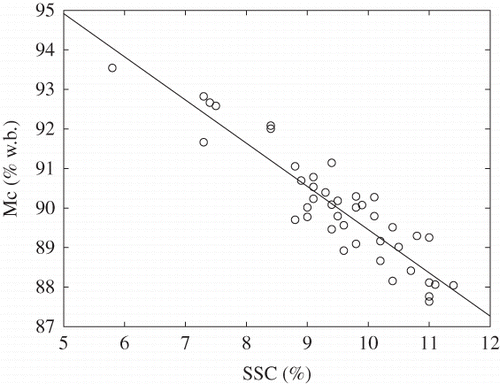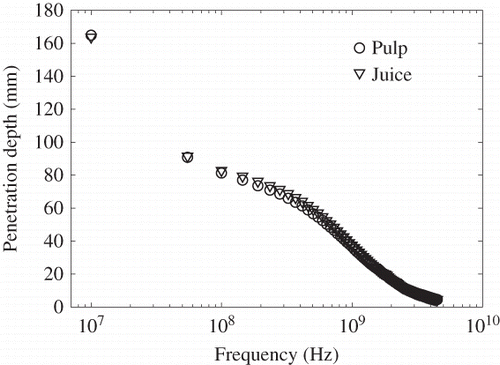Abstract
Permittivities from 10 to 4500 MHz at 24°C were measured on pulp and juice of watermelons of different maturities with an open-ended coaxial-line probe and network analyzer. The dielectric constant of both materials decreased monotonically with increasing frequency and loss factor had a minimum at about 1000 MHz. Moreover, the pulp and juice had very similar loss factor values at each frequency. Ionic conduction is the major loss mechanism at lower frequencies in this range, while dipolar losses are dominant at the higher frequencies. The best linear coefficients of determination, 0.8 and 0.69, were found at 4500 MHz for correlations between the loss tangent of juice and soluble solids content and between loss tangent of juice and soluble solids content/pH, respectively. The penetration depth of electromagnetic energy in pulp and juice at 4500 MHz was 4 mm. The study offers useful information in assessing watermelon quality from dielectric properties.
INTRODUCTION
Quality of fresh fruits depends on many physical characteristics, such as size, shape, weight, color, firmness, defects, and chemical properties (i.e., sweetness, acidity, and flavor). Therefore, grading and sorting fruit is very difficult. Many of the specific quality attributes (i.e., sweetness, acidity, flavor, firmness, and color) in some cases determine whether a fruit appeals to the customer. Sensing fruit quality, especially nondestructively and rapidly, can be helpful in harvesting, processing, and marketing. Therefore, various quality sensing technologies based on changes in physical properties (i.e., acoustic, electrical, optical, and mechanical) during fruit ripening and subsequent storage have been explored. These have included ultraviolet, visible and near-infrared spectroscopy, computer vision, dielectric or electrical properties, sonic and ultrasonic techniques, mechanical, X-ray, magnetic resonance, and bio-sensor methods.Citation[1, Citation2]
Progress in studying dielectric properties of fruits was summarized in a previous study.Citation[3] Recent research on fruit dielectric properties focused on relationships between permittivities and internal quality indicators, such as sweetness measured by soluble solids content (SSC). Poor correlations between external surface permittivity measurements and SSC in honeydew melons,Citation[4] watermelons,Citation[5] and applesCitation[3] suggest that it is very difficult to sense fruit internal quality nondestructively through dielectric properties. However, the permittivities of internal tissue and juice of honeydew melons were related with sugar content and moisture content.Citation[4, Citation6, Citation7] Similar studies were carried out on correlations for internal tissue and juice of watermelonsCitation[5] and applesCitation[3] over the frequency range from 10 to 1800 MHz, and the results were not as good as those found in honeydew melons. The research was conducted by using four watermelon cultivars and three apple cultivars. The lower correlations might have resulted from the diversities of physical and chemical properties of different cultivars. The objective of the study reported here was to further investigate the relationship between the permittivities and quality parameters of watermelon edible pulp and juice with a single cultivar, ‘Qishan 4th’, over a broader frequency range form 10 to 4500 MHz. The watermelons were harvested with different maturities for dielectric properties measurements of pulp and juice at 24°C, along with measurements of soluble solids content and pH of juice and pulp moisture content. Moreover, the electrical conductivity of juice was investigated to determine its contribution to dielectric loss in watermelon pulp and juice at different frequencies.
MATERIALS AND METHODS
Dielectric Theory
Permittivity, a complex quantity commonly used to express the dielectric properties, can be used to calculate the influence of a material on electric fields and the absorption of energy from radio-frequency (RF) and microwave (MW) electric fields. Of usual interest, is the relative complex permittivity, i.e., the permittivity of a material relative to that of free space, 8.854 × 10−12 F/m. It is expressed as:
The real part, is the dielectric constant, which is associated with the capability for energy storage in the electric field in a material. It also influences the amount of electromagnetic energy reflected from a product or transmitted into the product. The imaginary part,
is the dielectric loss factor, which represents energy dissipation in the material or the conversion from electric energy to heat energy, and
Another important parameter used in electromagnetic theory is the loss tangent,
The mechanisms that contribute to the dielectric loss in heterogeneous mixtures include polar, electronic, atomic, and Maxwell-Wagner responses.Citation[8] At radio and microwave frequencies, the loss mechanisms of foods and agricultural products are dominated by dipolar losses and ionic conduction.Citation[9] This can be mathematically expressed as:
Penetration depth, dp , of RF and MW power is defined as the depth into the material at which the power is reduced to 1/e (e = 2.7183), about 37% of its value at the surface of the material. It is a very important parameter in characterizing MW heating. Penetration depth in a lossy material can be calculated as follows:[8]
Watermelons
Watermelons (Citrullus lanatus (Thunb.)) of ‘Qishan 4th’ cultivar with different maturity were used for the study. The pulp color of watermelons used in the study was from light red to red, the seed color changed from white (immature watermelon) to black (mature watermelon). About eight watermelons were picked from a local field in Yangling, Shaanxi, China, the afternoon of the day before each scheduled measurement series. After the samples were washed with tap water, they were kept at 24°C and allowed to equilibrate overnight. Overripe watermelons were not used. In total, 42 watermelons were measured in the study. Soluble solids content ranged from 5.8 to 11.4%, pH from 5.1 to 6.3, and moisture content from 87.6 to 93.5% wet basis.
Dielectric Properties Measurements
The dielectric properties were measured with an Agilent Technologies 85070E open-ended coaxial-line probe and an Agilent Technologies E5071C network analyzer at frequencies ranging from 9 kHz to 4500 MHz (Agilent Technologies, Penang, Malaysia). A computer and Agilent Technologies 85070C dielectric probe kit software were used to control the signal source and to acquire data from the network analyzer. They were also used to calculate the dielectric constant and loss factor from the reflection coefficient at each frequency and print them graphically. The loss tangent was calculated from a dielectric constant and loss factor. Settings were made to provide measurements at 101 frequencies on a linear scale from 10 to 4500 MHz. Before measurements, the E5071C network analyzer was calibrated with an open, short, and matched load in sequence. Then, the low-loss coaxial cable for the open-ended coaxial-line probe was connected to the calibrated port. The Agilent Connection Expert program was initiated, which performed the instrument setup. The 3-mm diameter coaxial dielectric probe, with 18.96 mm in diameter ground-plane flange, was calibrated by using air, short-circuit, and 25°C deionized water, and a measurement was made on 25°C deionized water to verify that proper permittivity values were being obtained.Citation[10]
Moisture Content Measurement
Moisture content of watermelon pulp was determined by drying triplicate samples of about 8 g in disposable 55-mm aluminum weighing dishes in a forced-air drying oven (WG-71, Tianjin Taisite Instruments Co., Ltd., Tianjin, China) at 70°C for 24 h. Upon removal from the oven, the weighing dishes and samples were cooled in a desiccator over anhydrous calcium sulfate until the sample temperature cooled to room temperature before reweighing the samples. Moisture contents were calculated on a wet weight basis by using the sample's original weight and moisture loss.Citation[5, Citation7] The average of triplicate samples from each watermelon was calculated.
Soluble Solids Content Determination
Sugar content can be measured directly by chemical means but, since sugar is the major component of soluble solids in fruit, it is easier and quicker to measure soluble solids content in extracted juice with a refractometer.Citation[11] Soluble solids content is usually used as the sugar content index. The soluble solids content was determined with an Atago Pallete Series Model PR101α digital refractometer (Atago Co., Ltd., Tokyo, Japan). Three replicated SSC readings were taken for each sample and the mean was used.[7,12]
pH Determination
Acidity (titratable acidity) is another important chemical characteristic. The titratable acidity and pH are not directly related as the latter depends on the concentration of free hydrogen ions and buffering capacity of the extracted juice.[11] But pH is a convenient measure, easily made with an inexpensive pH meter, thus, it is widely used in laboratory experiments and in industrial processing. The pH value of watermelon juice was determined with a PHSJ-3F pH Meter (Shanghai Precise Scientific Instrument Co., Ltd., Shanghai, China). Three replicated pH readings were averaged for each sample.Citation[12]
Conductivity Determination
In order to study the influence of ionic conductivity on the loss factor, electrical conductivity of watermelon juice was measured with an electrical conductivity meter (DDSJ-308A, Shanghai Precision & Scientific Instrument Co., Ltd., Shanghai, China). Mean values were calculated from three replications.Citation[13]
Experiment Procedures
After warming up for at least 1 h, the network analyzer and open-ended coaxial-line probe were calibrated in sequence. A previous study has shown that watermelon pulp thickness, from 2 to 5 cm and pulp diameter, from 19 mm, which is close to probe diameter 18.96 mm to 30 mm, didn't have influence on permittivity measurement. Therefore, an equatorial slice about 4 cm thick was cut from the center of the watermelon perpendicular to the proximal-to-distal axis. Three cylindrical core samples on radii about 120° apart, avoiding the seed-bearing regions, were cut from the slice near the center with a 19-mm-diameter cylindrical cutter. The sample was placed on a laboratory jack and raised to provide firm contact with the probe for the permittivity measurement. Care was taken to insure good contact and avoid excess probe pressure on the pulp specimen. After the measurement was done, the sample was removed from the jack, turned over, and permittivity measurement for the opposite end was conducted. Mean values were calculated for the six measurements from the three cylindrical samples of each watermelon at 101 linearly discrete frequencies from 10 to 4500 MHz. Juice from the samples used for pulp dielectric property measurements of each watermelon was expelled into a plastic dish with a garlic press with two layers of cheesecloth patches. The juice was filled into a 10-ml beaker with 22.5 mm in inner diameter after stirring evenly. The height of the juice in the beaker was about 26 mm. A previous study had shown that the beaker size, such as 10, 25, 50, and 100 ml, when the juice height was at least 20 mm, had no influence on permittivity measurement. Three measurements were done for each juice sample and the mean was calculated. Then soluble solids content, pH, and electrical conductivity of the juice were measured in sequence. For moisture content measurement, three more cylindrical pulp samples from locations adjacent to the samples used for the other quality measurements were used. The mean and standard deviation of replications for each index were calculated with Microsoft Excel 2007 (Microsoft Corporation, Redmond, WA, USA).
RESULTS AND DISCUSSION
Frequency-Dependent Dielectric Properties
Mean values and standard deviations of the dielectric constant and loss factor of pulp in six measurements and juice in triplicate for a single mature watermelon at 24°C over the frequency range from 10 to 4500 MHz are shown in and shows that the dielectric constant of pulp and juice had a similar trend and decreased monotonically with increasing frequency over this frequency range. As frequency increases, the ionic motion and dipolar rotation cannot follow the alternating electric field and there is a lag. It is expressed as a decrease in the dielectric constant with increasing frequency. At frequencies above about 50 MHz, the dielectric constant of juice was about 4% higher than that of the pulp, but it is less than 1% lower than pulp when frequency was lower than 50 MHz. The differences in dielectric constant may lie in ionic density differences in pulp and juice. More ionic activity in juice than in pulp results in the greater dielectric constant of juice compared to that of the pulp. The loss factor values of the pulp and juice were nearly the same, with the loss factor of juice slightly higher than that of pulp (). The loss factor decreased with increasing frequency to a minimum around 1000 MHz and then increased as frequency continued to increase. also shows that the loss factor at lower frequencies varies linearly with frequency in the log-log plot. The linear correlation can be explained with EquationEq. (3). By taking the logarithm of both sides of EquationEq. (3):
Figure 2 Mean values and standard deviations of loss factor of pulp in six measurements and juice in triplicate of a mature watermelon at 24°C.
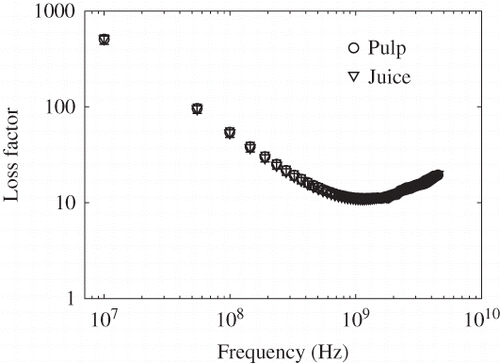
Figure 1 Mean values and standard deviations of dielectric constants of pulp in six measurements and juice in triplicate of a mature watermelon at 24°C.
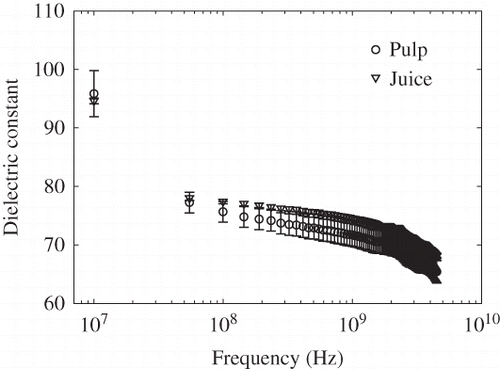
Clearly, the loss factor attributed to ionic conduction has a negative linear relationship with frequency in the log-log plot. Therefore, the loss factor component attributable to ionic conduction can be calculated from electrical conductivity, which can be determined by an electrical conductivity meter. The measured electrical conductivity of watermelon juice was from 0.08 to 0.23 S/m, which was lower than that of apple, orange, and pineapple juices.Citation[14] The loss factor calculated from conductivity meter readings on watermelon juice is compared with the loss factor measured with the coaxial probe in The calculated loss factor was similar to that measured at the lower frequencies, indicating that the ionic conduction is the major contributor to the relaxation losses in watermelon juice at the lower frequencies, while that at the higher frequencies results mainly from dipolar relaxation. The similarity of measured and calculated loss factors suggests that electrical conductivity measured with a conductivity meter, which is much cheaper than a network analyzer, can be used to predict loss factors of pulp or juice at RF. Also, the closeness of loss factors of pulp and juice means that the electrical conductivity of juice can be used to predict the loss factor of pulp.
Correlation Between Permittivity and Quality Indicators
An aim in studying the dielectric properties was to look for a better correlation between dielectric properties and watermelon quality, especially the soluble solids content, since sweetness is the most important quality attribute for melons. Better correlations were found in honeydew melons.[4,6,7]
On the new watermelon data, linear regression analyses between permittivities, i.e., dielectric constant, loss factor, and loss tangent, of pulp and juice and soluble solids content were conducted for 101 discrete frequencies from 10 to 4500 MHz. The regressions revealed that the best correlations were found between loss tangent and SSC at 4500 MHz. Linear regressions of soluble solids content on loss tangent of pulp and juice at 4500 MHz at 24°C are shown in and , respectively. The coefficient of determination in for pulp was only 0.41, but it was 0.80 for juice. The regression formula for is as follows:
Figure 5 The linear regression between loss tangent of juice and soluble solids content at 4500 MHz at 24°C for the 42 watermelons in this study, R 2 = 0.80.
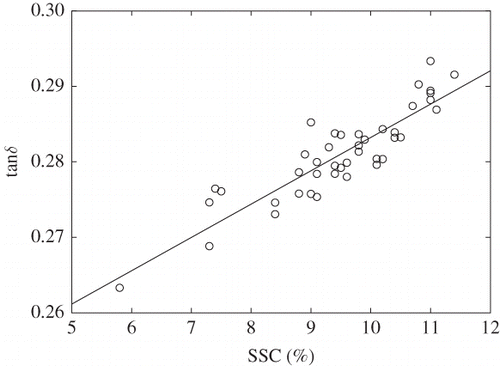
Figure 4 Linear regression of pulp loss tangent on soluble solids content at 4500 MHz at 24°C for the 42 watermelons in this study, R 2 = 0.41.
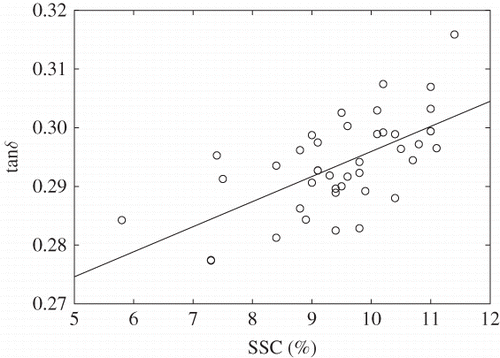
Therefore, the soluble solids content can be calculated from the permittivity values of watermelon juice.
Although sugar content is the desirable important internal quality, the sugar/acid or soluble solids content/acid ratio is a better indicator for palatability and flavor of the fruit than either sugar or acid levels alone.[11] Linear regressions were also calculated for the dielectric constant, loss factor, and loss tangent on the soluble solids content/acid ratio, The best linear coefficient of determination, 0.69, was found for the loss tangent at 4500 MHz. The regression of
on
is illustrated in , and formula (7) can be used to describe their relationship:
Figure 6 Linear regression of juice loss tangent on SSC/pH at 4500 MHz and 24°C for the 42 watermelons in this study, R 2 = 0.69.
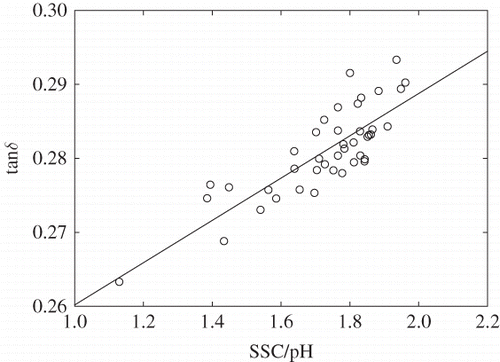
The linear coefficients of determination between permittivities and pH and between permittivities and moisture content were less than 0.4. However, there was a strong linear relationship between soluble solids content and moisture content, with R 2 of 0.84 (). This relationship was also found in honeydew melons (R 2 = 0.972 and R = 0.92),[4,7] watermelons (R 2 = 0.906),[5] and apples (R 2 = 0.94).Citation[15]
Penetration Depth
The penetration depth, calculated from the measured dielectric properties of pulp and juice in and at 101 frequencies over the frequency range from 10 to 4500 MHz at 24°C, is shown in As expected, the penetration depth decreased with increasing frequency. It decreased more rapidly at the lower frequencies than at the high frequency end showing values of 165, 39, 12, and 4 mm in pulp, and 164, 41, 12, and 4 mm in juice at 10, 915, 2450, and 4500 MHz, respectively. It was calculated that the best sample thickness for watermelon pulp and juice permittivity measurement at MW in the study is about 20 mm.Citation[16] Usually, the rind of watermelons was thicker than 10 mm, but the penetration depth was 4 mm at 4500 MHz, where the best correlation was obtained. This makes successful external sensing of sweetness through dielectric properties very unlikely. However, the permittivities of juice at 4500 MHz may be used in sensing soluble solids content.
CONCLUSIONS
Permittivity measurements on edible pulp and juice of mature watermelons from 10 to 4500 MHz revealed dielectric constants of juice about 4% greater than those of pulp above about 50 MHz and less than 1% smaller than pulp below 50 MHz, with values of both decreasing monotonically with increasing frequency. Dielectric loss factors of pulp and juice were very similar, decreasing as frequency increased from 10 MHz to about 1000 MHz and then increasing at higher frequencies. The highest correlations between dielectric properties and quality factors (soluble solids content and soluble solids content/acid ratio) were obtained for the loss tangent at 4500 MHz with linear coefficients of determination of 0.8 and 0.69, respectively. No significant correlations were noted between permittivities of pulp and soluble solids content, pH, soluble solids content/pH, or moisture content. Penetration depths for electromagnetic energy in watermelon pulp and juice at 4500 MHz were only 4 mm, indicating very limited possibilities for nondestructive sensing of watermelon quality by external measurements through dielectric properties.
REFERENCES
- Abbott , J.A. 1999 . Quality measurement of fruits and vegetables . Postharvest Biology and Technology , 15 ( 3 ) : 207 – 225 .
- Ying , Y. , Han , D. , Wang , J. and Wang , J. 2005 . Non-Destructive Detecting Technology in Agri-Products , Beijing : Chemical Industry Publisher .
- Guo , W. , Nelson , S.O. , Trabelsi , S. and Kays , S.J. 2007 . 10-1800-MHz dielectric properties of fresh apples during storage . Journal of Food Engineering , 83 ( 4 ) : 562 – 569 .
- Guo , W. , Nelson , S.O. , Trabelsi , S. and Kays , S.J. 2007 . Dielectric properties of honeydew melons and correlation with quality . Journal of Microwave Power & Electromagnetic Energy , 41 ( 2 ) : 44 – 54 .
- Nelson , S.O. , Guo , W. , Trabelsi , S. and Kays , S.J. 2007 . Dielectric properties of watermelons for quality sensing . Measurement Science and Technology , 18 : 1887 – 1892 .
- Guo , W. , Nelson , S.O. , Trabelsi , S. and Kays , S.J. 2008 . Radio frequency (RF) dielectric properties of honeydew melon and watermelon juice and correlations with sugar content . Transactions of the Chinese Society of Agricultural Engineering , 24 ( 5 ) : 289 – 292 . in Chinese
- Nelson , S.O. , Trabelsi , S. and Kays , S.J. 2006 . Dielectric spectroscopy of honeydew melons from 10 MHz to 1.8 GHz for quality sensing . Transactions of the ASABE , 49 ( 6 ) : 1977 – 1981 .
- Metaxas , A.C. and Meredith , R.J. 1993 . Industrial Microwave Heating , London : Peter Peregrinus Ltd .
- Ryynänen , S. 1995 . The electromagnetic properties of food materials: A review of the basic principles . Journal of Food Engineering , 26 ( 4 ) : 409 – 429 .
- Agilent Technologies, Inc . 2005 . Application note: Basics of measuring the dielectric properties of materials Santa Clara , CA Agilent literature number 5989-2589ENAgilent Technologies, Inc., USA
- Wills , R.H.H. , Lee , T.H. , Graham , D. , McGlasson , W.B. and Hall , E.G. 1981 . Postharvest—An Introduction to the Physiology and Handling of Fruit and Vegetables , Westport , , Connecticut : The AVI Publishing Company Inc .
- Chen , Y. and Li , S. 2007 . Food Analysis and Inspection , Beijing : Chemical Industry Press . in Chinese
- Wang , Y. , Tang , J. , Rasco , B. , Kong , F. and Wang , S. 2008 . Dielectric properties of salmon fillets as a function of temperature and composition . Journal of Food Engineering , 87 : 236 – 246 .
- Amiali , M. , Ngadi , M.O. , Raghavan , V.G.S. and Nguyen , D.H. 2006 . Electrical conductivities of liquid egg products and fruit juices exposed to high pulsed electric fields . International Journal of Food Properties , 9 ( 3 ) : 533 – 540 .
- Guo , W. , Zhu , X. and Zou , Y. 2007 . Electrical properties of apples during ripening . Transactions of the Chinese Society of Agricultural Engineering , 23 ( 11 ) : 264 – 268 . (in Chinese)
- Agilent Technologies, Inc . 2003 . Technical overview: 85071E materials measurement software Agilent literature number 5989-0222ENAgilent Technologies, Inc., Santa Clara, CA, USA
